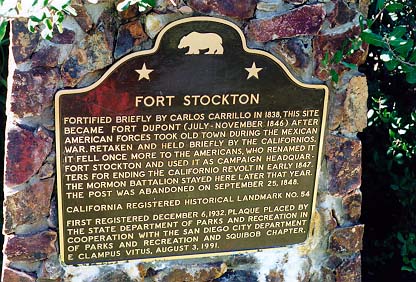When the United States forces first arrived in San Diego on board the sloop-of-war USS CYANE, under the command of Captain Samuel F. DuPont, San Diego was easily seized by the sailors and marines from the CYANE, supported by the California Battalion led by Lieut. Colonel John C. Fremont.
The American flag was raised over San Diego, on July 29, 1846, at 4 p.m., by Lieut. Stephen C. Rowan, USN, at the Plaza San Diego Viejo. Upon the capture of San Diego, the fortifications on top of Presidio Hill were strengthened and re-named Fort DuPont, in honor of the captain of the CYANE. Ten days after the Stars and Stripes fluttered up the pole in the Plaza, the CYANE and Fremont's troops departed for Los Angeles.
Upon the departure of the CYANE, San Diego was left virtually unprotected. Captain Ezekiel Merritt and John Bidwell had been left in charge of the American garrison in San Diego. Captain José Maríía Flores, from the pueblo of Los Angeles, sent Francisco Rico and Serbulo Varela with fifty men to recapture San Diego now held by the Americans. Fearing that they would be overrun by the Mexican forces, the Americans abandoned Fort DuPont and San Diego as a group of Californios loyal to Mexico recaptured the town in early October 1846. Without firing a shot, the Mexicans drove the remaining Americans to take shelter on the Bay aboard the Yankee whaler STONINGTON which was anchored in the harbor.
Once again the Mexican flag floated over San Diego. The Mexican forces held San Diego for nearly three weeks.
The Americans on the whaling ship STONINGTON were disturbed by the existence of two Spanish cannon on Presidio Hill. The possibility that the Californios might bring them down to the water's edge drove a young New Yorker named Albert B. Smith to go ashore and spike the guns in the fort a top of Presidio Hill. He reached Presidio Hill undetected, crept up to its summit, and hammered spikes into the cannons' touch-holes.
Encouraged by Smith's success, on October 24, 1846, the American volunteers aboard the STONINGTON rowed ashore, formed in battle array, charged the Mexican defensive positions. The Mexican commander, Serbulo Varela had been ordered to send most of his men back to Los Angeles to protect that town from an expected attack on that city. After a brief skirmish the Americans retook possession of the city. The Californios retired without offering resistance.
Once again, the Americans were in possession of the San Diego. As the Americans began to haul down the Mexican flag, Maríía Antonia Machado rushed to saved it from being trampled upon. She clutched it to her bosom, and cut the halyards to prevent the American flag from being raised. Smith shinnied up the flag pole and nailed the American flag to the flagpole in the Plaza.
Two days later, on October 26, 1846, Captain Leonardo Cota and Ramon Carrillo arrived with 100 men and laid siege to San Diego intending to force the Americans to surrender. For the next several months the Americans were captive inside the pueblo. Skirmishes were a daily occurrence. Commodore Robert F. Stockton, supreme commander of operations on the coast, reported:
"The situation of the place was found to be more miserable and deplorable. . . . On the afternoon of our arrival the enemy came down in considerable force and made an attack; they were, however, soon driven back with the loss of two men and horses killed and four wounded. These skirmishes, or running fights, were of almost daily occurrence. Since we have been here we have lost as yet but one man killed and one wounded."
In November 1846, Stockton arrived aboard the sixty-gun ship CONGRESS to relieve the town of further harassment from the Mexican's encampted on the hill which dominated the town. Two San Diegans, Santiago Arguello and Miguel de Pedrorena, sympathetic to the idea of American domination, led the attack on the Mexican positions, driving the enemy from the hill and up the Mission Valley.
Eventually more than 700 American troops would enter San Diego in preparation for the build up for the recapture of Los Angeles. Nevertheless the siege was effective.
At this point, Stockton's forces retook the strong hold once called Fort DuPont. Stockton immediately set out to strengthened Presidio Hill with earthworks and posted a garrison of a hundred men there to defend the city. He renamed it Fort Stockton.
At its best, Fort Stockton could only be described as a broad ditch backed by earth-filled barrels, between which the muzzles of twelve Spanish guns.
The last military company to be assigned at Fort Stockton was when the Mormon Battalion, under command of Lieut. Colonel Philip St. G. Cooke. The Mormon Battalion made camp at the San Diego Mission on January 29, 1847. After one of the longest marches of infantry in history, the Mormon Battalion arrived in California, too late to take part in the fighting at the Battle of San Pasqual. Company B was left at Fort Stockton to garrison the place with seven artillery pieces while the rest of the Battalion was sent on to Los Angeles.
The signing of the Treaty of Guadalupe Hidalgo, ending the Mexican era, caused Fort Stockton to cease to exist as a military post.
